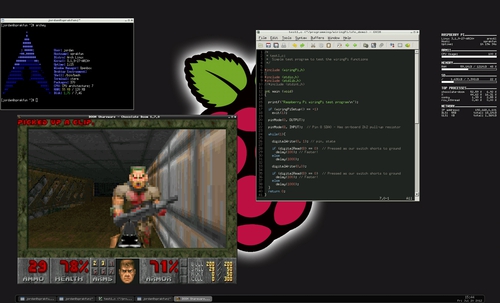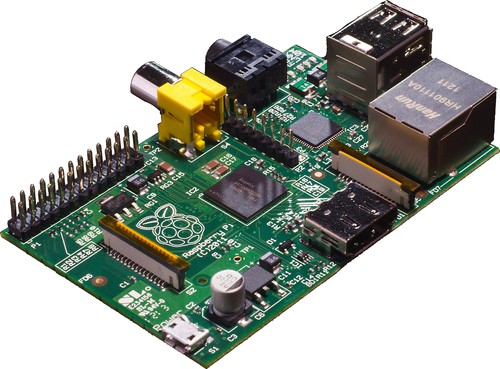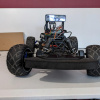The Raspberry Pi created quite the buzz on the internet prior to its release. Much like the rest of the electronics community, we here at SparkFun couldn't wait to get our hands on one. Well, we finally had the opportunity to do just that.
The Raspberry Pi, "An ARM GNU/Linux Box for $25"
So what is the Raspberry Pi? The Raspberry Pi is a cross between a typical embedded system, like an Arduino, and a desktop computer. The Pi definitely packs some power -- it sports a 700MHz ARM 11 Core with 256MB's of RAM and up to a 32GB SD card for storage. In the eyes of some, it's one of the more powerful embedded boards to hit the market. To others, it's one of the most compact, bare-bones personal computers ever to grace the electronics world with its presence. In either case, it's here to blur the line between the world of embedded electronics and personal computing.
Whether you're looking to learn more about Linux and programming or you're a Linux guru looking to make the leap into embedded electronics, consider the Raspberry Pi as a starting point. The Raspberry Pi is a great platform on which to learn because you can backup your SD card at any time, essentially creating an image of your work. No need to worry about breaking something. If anything goes horribly wrong, you can just reload your old image onto your SD and start over. One great use of the Pi could be as a home server to remotely control and do processing for other hardware, including other development boards like the Arduino.
The Raspberry Pi Foundation is attempting to be a catalyst in creating a world where every child has access to cheap programmable computers. We feel this is similar to our own values of creating a world where electronics are easily accessible to everyone and an integral piece of their education.
To help accomplish those missions, we have written a tutorial to assist those who might be new to the Raspberry Pi and are considering the dive into the Arch Linux ARM distribution. By the way, who remembers playing this game?
Well, instead of playing Doom on that old DOS box you have buried in the basement, you can play it on the Raspberry Pi. In addition to being able to play this game, you can learn what hardware you need to get started, how to configure a Linux box and even how to use the Pi to control or interact with other hardware by attempting to control the physical IO pins with the help of the Wiring Pi library.

The Raspberry Pi Desktop, Ready for Work or Play
At the end of this tutorial, you will have a fully functional desktop computer environment setup like the screenshot above, ready for your computing, programming, or playing needs.
Although we don't have the actual Raspberry Pi board in our catalog at this time, we do think it is an awesome tool for those looking to take their projects to the next level by mixing the worlds of Linux and embedded electronics. We're excited to see what the community does with this hardware. Expect some Raspberry Pi related products from SparkFun in the not too distant future. Enjoy!










My co-workers are having a really hard time grasping the concept that you are promoting an amazing product that you don't even carry. Of course, they also have a hard time with the concept of open source, too.
About not carrying it... It would be great if we could get them off SFE...
Always looking out for new things to adapt wiringPi to! -Gordon
Props for creating the WiringPi library, a great resource!
Just so you know, the Devs behind Arch Linux ARM were kind enough to add your WiringPi library/examples to the official repositories.
Instead of making users download a tarball and compile it all themselves, they can simply install it with the package manager and everything is taken care of for them with one command:
pacman -S wiringpi
After this, they can use the gpio command, use your library in C, and see your examples and run them in the following directory:
/usr/share/wiringpi/examples
It's a good thing to see Sparkfun embracing the Raspberry Pi as part of the electronics universe. Please consider some tutorials about interfacing your awesome parts to this cool platform.
And to others - an auto parts store doesn't have to have a Ferrari to carry parts that could make it cooler ;-)
Just want to say that I am loving my RaspberryPi. Theres a large community on the official forums and #raspberrypi on freenode. I've gotten MAME, MESS, and Gngeo (NeoGeo) emulation working on my Pi, as well as Cave Story running on it. I'm really glad to see sparkfun giving this awesome board some coverage. I hope to see SparkFun selling the open hardware accessories for the Pi at some point.
For the above programs, I have binaries, source code, and tutorials available on my site: http://blog.sheasilverman.com
I snagged one of these by waiting up on "opening day" to get in the queue and then waiting a few months for delivery. It is every bit as impressive as it sounds. The gpio pins are available for doing all the things you would normally use them for (blinking led lights right?), but it has no analog pins. You'll need something else to do the analog to digital conversion. There are articles on marrying this with an Arduino to provide the best of both worlds. The gertboard seems to be an attempt to bring analog access and motor driver access to the pi (http://www.raspberrypi.org/archives/868).
I've played with mine on a breadboard (and the adafruit pi cobbler with ribbon cable made that a snap) and I've even turned it into a uber-featured home firewall with an $11 additional USB network card.
Long and short is that it's a great learning tool no matter which direction you are coming from (embedded or pc) and it can end up being a very powerful addition to many projects.
I think if Sparkfun wanted to be involved in the ecosystem around this product there is plenty of opportunity for classes, projects, breakout cables, boards, DACs, lcd hookups, and tons more.
How much do you have to spend before it has the features of this http://www.andahammer.com/mini35-sdk/ ? Add some Sparkfun BOBs on the GPIO (it has multiple Analog channels already) or the 4 serial TTL UARTS. You wouldn't get the fast video, but ???? It has I2C and SPI and I use a bunch of SF breakouts on one. Mine is running Debian with Python for MFD (Mighty Fast Development). Android users can keep their Java. The whole scientific community has gone Pythonic.
That's a great device. Just bookmarked that, mentally and in my browser. I think the price thing that the Pi has that appealed to me is a very low entry for just the bare (and not too bare at that) bones and then one can add pieces as needed. There certainly is the integration work already done on the mini35 that is worth $, not to mention the additional out of the box features. So far I'm only out of the pocket $46 (had the usb charger power supply and SD card in my parts box already).
Agreed, python seems to be everywhere these days!
Just got my Raspberry Pi via Newark yesterday. Amazing little guy! And this is the tutorial with which to fire it up!
Newark Stock No: 83T1943 RASPBERRY PI MODEL B - BOARD ONLY; Silicon Manufacturer:Broadcom; Core Architecture:ARM; Core Sub-Architecture:ARM11; Silicon Core Number:BCM2835 Cost was $35 + $5 shipping + $1.60 tax
Funny, just a couple of days ago my son and I were wondering if this was do-able on a Pi. Now Sparkfun has done it!
Best of all, my two long back ordered Pi boards are on the UPS truck for delivery some time today! I guess we know what I'll be doing with one of them.
Rapsberry Pi $35 Great info from Sparkfun Pricele$$
Thanks Sparkfun.
yeah i got one. it's awesome. :)
I got in early and received mine in May. Definitely worth $35.
"Expect some Raspberry Pi related products from SparkFun in the not too distant future."
Definitely looking forward to it! I have a Rpi, but I haven't used it very much, it's been sitting there for weeks waiting for me to have an idea. I just got an idea yesterday (webcam+Rpi+photoresistor or door switch), and some accessories (a case, a prototyping shield with a breadboard) would be great. In fact, a case with a power supply and a built-in powered USB hub would kick ass!
I love my Raspberry Pi. It is easily the best $35 I have ever spend on a board. It's great to see Sparkfun doing some Pi related products.
Does anybody know where you can buy one of these things? I signed up at Newark/Farnell but I'm still waiting. Is there a way to use the Beagle Bone to run some of the stuff that the Pi does. (I know the Bone doesn't have any video hardware).
Newark says "100 Expected to ship 16 Aug, 2012" They got me mine in good time.
Bear in mind that as of a minute ago, some of the sellers are saying "order now for delivery in up to 5 weeks." So they have a production pipeline working, but not necessarily set up to meet current demand.
http://www.farnell.com/ and http://www.rs-components.com/raspberrypi
RS components is part of Allied Electronics. Sounds like Rat Shack. Wonder if the shack will carry them eventually. Well I placed ANOTHER notify me when available request to both of them. I think the only way to get one of these is on Ebay and pay twice (or more) what it's worth.
The Shack might get them, if the recent addition of (overpriced) Arduinos and accessories is anything to go by. I'd go with Farnell.
It would be a pretty bad move by Sparkfun to get into supporting a software intense platform. They have avoided the bottomless pit of software support so far. I can tell you from experience that 90% of new users immediately dump the OS and try to compile their own Linux and currently Android - with mixes of source and online tutorials that don't go together. Then the question and pleading for help begins. Plus, I don't think they are $25. That was the pre-shipping estimate. Now they are $35 to $45 depending on your source, and there is a lot of ARM stuff that competes at that level. I have been wondering when a US maker (TI and Beagle/Panda, Freescale, etc) will file anti-dumping because of the below cost selling - volunteer labor, sweetheart deal with Broadcom, Raspberry officer and Pi designer is paid as head chip designer at Broadcom, etc. If any is true, a case could be made. (Note the Brits accuse nearly everyone else of dumping).
However, looking at the IRC's for Panda, Beagle, And Pi, there are 250 or so online at any moment and that is impressive. Though a low interaction and comment rate for some reason. I think most are just lurking waiting for SOMEONE to show up who has some answers.
Been there before? :-) Nate wrote about the pitfalls in growing a business, and software support is definitely one of the major sinkholes that is under-estimated in tech firms. I have admired how Sparkfun has grown with product lines that require very little or no support beyond a few forums and wiki's, nearly all managed by others. The enthusiasm for those elementary "According to Pete" episodes is pretty amazing. You guys have really hit the sweet spot. (I'll note that even EDN now has stories in which they simply take apart new products and look at the cool stuff inside. They can't get enough real engineering copy and rerun Williams and Peas material. Circuit Cellar is more sophisticated than the professional trade mags. Maybe new engineers are getting their instruction from Pete :-0 )
The $25 version has different network options. The $35 one is what you want anyway. If you want to buy one now you'll have to go on ebay and end up in a bidding war paying close to $100 to snag one.
I thought you guys will never going to talk about the Pi and adafruit already have a line of products for the Pi
Well due to stock issues, it took a looong time to get our hands on a Pi. Now that we have one, you can expect to see some related products soon.
I wish we could be a distributor of the board itself, because it's a rather powerful little board with a lot of potential, both for teaching embedded electronics and desktop Linux, really blurring the line between the two.
For now though, this tutorial demonstrates what can be done with the board, and helps those who did buy a Pi and are as lost as I was when I first started playing with the board.
The Gertboard (http://www.bit-tech.net/news/hardware/2012/08/09/gertboard/1) has just been announced and orderable for the Raspberry Pi!!
Looks like a GREAT board, more comprehensive then any breakout board I've seen for Arduino yet. AND has an onboard Arduino to boot!
Although it's $50, with a Pi about $95 total. It's really not that far off from a Uno R3 and an Ethernet Shield ($80). Since most of my projects I need an Ethernet shied as well. I think the Pi with the Gerboard is an excellent hybrid solution with many more capabilities, and for only about $15 more.
I REALLY hope Sparkfun starts carrying these products - Would like to buy U.S. vs. U.K
Thank you for the tip about adjusting the start.elf file. That sped things up quite a bit.
Doom was great but have to admit I liked Wolfenstein 3D a bit more. You know the original one with Nazis in it.If we can get some Wolfenstein 3D ported as well then I might have to get one of these bad boys for some serious early 90's gaming.
There's a StackExchange QA site for the RasPi - http://raspberrypi.stackexchange.com
"a world where every child has access to cheap programmable computers"
Anyone else thinking Megaman BN?
I've been watching this board out of the corner of my eye since it was initially announced. I understand the desire to keep the price down, but I'm kind of put off by the single source marketing. I'd prefer they used distributors like Sparkfun and let the market dictate the price more.
As such, I'm using the Beagleboard xM instead. It's a more expensive board, but you can get it at will. One feature of the Rasberry Pi that will appeal to Linux noobs (I have difficulty configuring Linux. I'm not ashamed to admit that.) is that it comes with a working SD card. The Beagleboard ships with a "test card" that loads to a Ram Disk... any mods you make to the file system are lost on reboot. You have to learn how to properly make a bootable SD card with a Linux distro to use the board. (I used Narcissus to make an Angstrom build.)
Personally? I had a LOT of trouble getting the Beagleboard xM to run. All of it due to not making a proper, bootable SD card.
One thing I don't like about the Rasberry Pi is it's lack of mounting holes. How are you supposed to mount it?
My Beagleboard xM is connected to a network of Arduino clones through a daisy chained serial interface so I can communicate to all the Arduinos doing the hardware control through processes on the Beagleboard xM. I should revisit getting a Rasberry Pi to get it to work with that too.
Heh. I gotta wonder what Tony Stark used to make his first "Jarvis" system.
I really like my R-Pi, I ordered a second one but that may be months off yet. Meanwhile I got an "Olinuxino-Micro" (ARMv5, 64 MB, SD card, 1 USB) which is like a cheaper, less-capable Pi, but has many more I/O pins, and it is actually available for sale now. The O-Micro software is still very much a work-in-progress though (OE-Debian and Arch-Linux builds exist, but eg. no USB-WiFi adapter support yet). And Olimex has many distributors, SparkFun might even carry it, if they don't mind the software-sinkhole :-)
look at: pibow
Also, see: http://adafruit.com/products/859 , http://www.newark.com/bud-industries/ps-11591/raspberry-pi-enclosure-pcb-box/dp/92T3300 , http://www.designspark.com/knowledge/raspberry-pi-case , http://blog.makezine.com/2012/06/11/lego-raspberry-pi-enclosure/ , and http://www.yoctopuce.com/EN/products/raspbox
Forget Doom, Quake 1 is where it's at! :)
Naah, Castle Wolfenstein!!! :-)
We used to spend hours and hours playing Doom against each other. Back in the dial up (57,600 modem) college days!
I expect you to have these boards in stock soon, RIGHT ?
Are you guys going to carry the Raspberry Pi?
They specifically state on their site that they are not looking for distributors. So, no, unfortunately we won't be carrying it.
But you will offer lots of cool "go with" stuff, right?
For those with mounting concerns, Bud Industries makes two different enclosures specifically for the Pi, a round one and a square one. They are made from a translucent raspberry colored plastic. I have both. The round one offers cable management underneath, but I like the square one a little better. Perhaps enclosures are an item Sparkfun could carry. A snap-in mounting plate product would also be nice, and that is a product missing from the marketplace AFAIK.
While the single source aspect of the Pi is unfortunate, I'm sure it will create plenty of accessory demand for Sparkfun and the other "usual suspects".